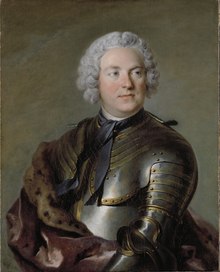Carl Gustaf Tessin
Carl Gustaf Tessin (born September 5, 1695 in Stockholm ; † January 7, 1770 at Åkerö Castle , municipality of Flen ), son of Nicodemus Tessin the Elder. J. , was a Swedish politician and imperial councilor as well as President of the State Chancellery, which he chaired between 1747 and 1752. From 1738 to 1739 he was land marshal (chairman) of the Swedish State Parliament . He is considered one of the most influential Swedish politicians of the 18th century.
family
His father came from a middle-class family and belonged to the lower nobility, his mother Hedvig Eleonora Stenbock (1658–1714), on the other hand, was from the high nobility, related to Queen Katharina Stenbock and maid of honor of Queen Hedwig Eleonora of Schleswig-Holstein-Gottorf .
Political career
Ticino chose a political-diplomatic career and was initially a supporter of the Holstein duke's party as the successor to the Swedish throne. From 1725 he was ambassador in Vienna . At the Diets of 1726/27 and 1731, where he made a name for himself as a brilliant speaker and leading representative of the Hat Party , he was in opposition to the government of Arvid Horn , who was supported by the Hat Party. In 1735/36 he was again ambassador to Vienna and in 1738 he was elected Marshal of the State Council. In 1739 he was instrumental in the overthrow of the government of Arvid Horn. From 1739 to 1742 he was ambassador to Paris, where his social agility and eloquence made him a major contributor to the alliance of Sweden and France sought by the hat party. In 1743 he was entrusted with an important diplomatic mission to Copenhagen to promote Danish-Swedish relations, and in 1744 he accompanied the sister of Frederick the Great Luise Ulrike of Prussia from Berlin to Sweden, where she married the Swedish Crown Prince Adolf Friedrich . From 1746 to 1752 he was President of the Reich Chancellery and thus headed Swedish politics. He tried to create a counterbalance to Russia through a connection with Denmark, but this alienated him from the king, who came from the traditionally anti-Danish house of Holstein-Gottorf. With the accession of Adolf Friedrich to the throne in 1752, his presidency ended and two years later he also lost his post as chief steward of Crown Prince Gustav . Ticino withdrew to his Åkerö estate.
Other interests
Ticino promoted art and science. Together with the architect Carl Hårleman , Ticino is considered to be the founder of the Royal Academy of Fine Arts . In 1741 he was accepted into the Royal Swedish Academy of Sciences . He had his own natural history collection and invited Carl von Linné , at that time still an aspiring doctor in Stockholm, with whom he became friends and whom he later encouraged many times, to live in his palace in Stockholm and to organize his natural history collection. In 1753 Linné's catalog of the collection was published (Museum Tessinianum). The collection of natural history at that time was in the nobility and bourgeoisie in fashion and also the King and Queen Luise Ulrike and Adolf Friedrich had a large collection that Linnaeus also ordered.
His wife was the lady-in-waiting Ulla Tessin , née Sparre, whom he married in 1727.
Works
- a 29-volume diary that has only been published in parts:
- Tessin och Tessiniana (1819), edited by Fredrik von Ehrenheim
- KG Tessins Dagbok (1824), edited by Gustaf Adolph Montgomery
- En gammal mans bref til en ung Prins (1756)
literature
- Carl Gustaf Tessin . In: Theodor Westrin, Ruben Gustafsson Berg, Eugen Fahlstedt (eds.): Nordisk familjebok konversationslexikon och realencyklopedi . 2nd Edition. tape 28 : Syrten-vikarna – Tidsbestämning . Nordisk familjeboks förlag, Stockholm 1919, Sp. 986 (Swedish, runeberg.org ).
Web links
- Correspondence between Carl Gustaf Tessin and Carl von Linné
Individual evidence
| predecessor | Office | successor |
|---|---|---|
| Per Axel Fleming |
Swedish envoy in Paris 1739–1742 |
Claës Ekeblad |
| Henning Adolf Gyllenborg |
Swedish envoy in Berlin 1744–1746 |
Christian Ehrenfried von Carisien |
| personal data | |
|---|---|
| SURNAME | Ticino, Carl Gustaf |
| BRIEF DESCRIPTION | Swedish politician and Reichsrat as well as President of the State Chancellery |
| DATE OF BIRTH | September 5, 1695 |
| PLACE OF BIRTH | Stockholm |
| DATE OF DEATH | January 7, 1770 |
| Place of death | Åkerö Castle, Flen (municipality) |

